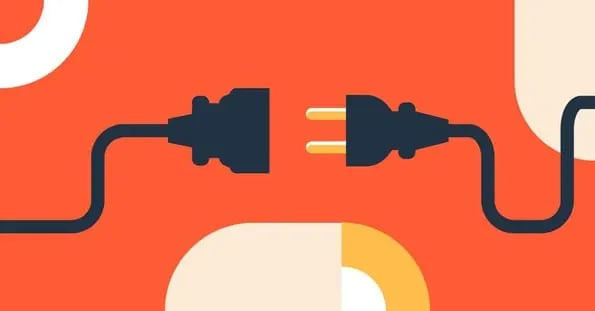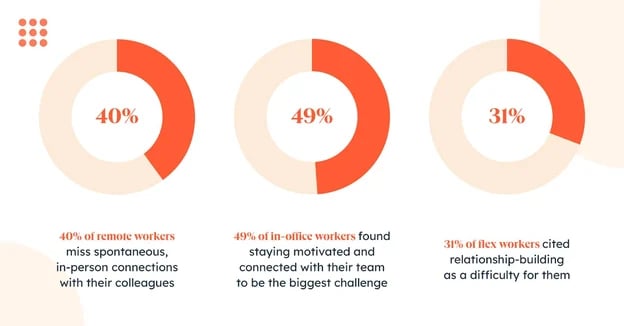This post is a part of The Crisis of Disconnection, a thought leadership series examining the latest research and insights to uncover how businesses can meet their growth goals, even amidst unprecedented changes to the way we work.

It’s no secret that reaching customers has become more challenging in recent years. Interested in going a few steps further to develop meaningful, lasting relationships? That’s an even taller order. To sustain business growth during trying times, many of us are realizing we need to reimagine how we attract, engage, and delight the communities we serve.
Until recently, it's been equally tricky to pinpoint a root cause for what feels like an uphill battle. The struggle, as they say, is real.
What is The Crisis of Disconnection?
At INBOUND 2022, we coined The Crisis of Disconnection to describe new headwinds facing businesses today. While it’s true that the emergence of new technologies and software has led to seismic shifts in buyer behaviors, that’s only one piece of the puzzle.
When we zoomed out, we discovered that disconnection is widespread across internal systems, among cross-functional teams, and — increasingly — between brands and their customers.
Yamini Rangan, Chief Executive Officer at HubSpot, sums up the Crisis of Disconnection best:

How did this evolution come to our attention? We’re glad you asked!
Research we’ve conducted over the last year has helped us bring these trends to light, and we’re eager to share our top findings. After all, overcoming The Crisis of Disconnection starts with understanding the challenges ahead. Let’s start with some high-level commentary on growth, or what’s top of mind for most in our current macroeconomic climate.
Want a rundown of all the data without the posts? Download our new report, Identifying & Solving for The Crisis of Disconnection
Growth Challenges Are on the Rise
Are times tough for most small businesses? All signs point to yes.
The economy is on a rollercoaster ride, the stock market is giving new meaning to the word "volatile," geo-political conflicts are escalating, and a global pandemic may have more unprecedented times in store. And that's just the tip of the iceberg. Tried-and-true methods for effective lead generation and organizational growth are becoming less and less reliable.
HubSpot’s Research Team found that 63% of businesses agree that growth strategies they used in the past are less effective than they used to be. Other top concerns for businesses right now include:
- Increasing expenses
- Increasing costs to reach customers and prospects
- Slowing growth
While growth challenges can be attributed to many factors, the heart of the problem stems from the same place: a lack of connection. New chasms between proliferating systems (leading to disconnected data), siloed teams (leading to internal friction), and companies and their customers (leading to disjointed experiences) are forcing businesses to evolve existing strategies and rethink their growth playbooks:

- A mere 22% of businesses report excellent data connectedness.
- Only 49% of U.S. workers feel their teams are working effectively in a hybrid environment.
- 64% of businesses agree that sales engagement is struggling more now than pre-pandemic.
Looking for a silver lining? The challenges we’re facing can pave the way for us to reconnect — with each other and our customers — in new ways. To understand how early adopters are (re)connecting the dots, let's take a look at the main drivers behind The Crisis of Disconnection, starting with the biggest pain point for scaling businesses (and the first of three emerging workplace trends threatening sustainable business growth).
What's Driving Disconnection?
1. Internal systems are disconnected.
When COVID-19 first broke out, we shifted many of our daily activities from in-person to online. We did it out of necessity, both personally and professionally. Now, as companies embrace increasingly digital ways of working on a permanent basis, streamlining systems to increase efficiency, decrease friction, and accelerate connectivity is more important than ever.
Spoiler alert — achieving that aim is proving to be easier said than done. Disconnected systems are the #1 pain point for companies in our market.
According to our research:
- 74% of businesses report they need to switch between many different tools to get their jobs done. (Fun fact: the average growing company uses 242 SaaS tools).
- While 65% of businesses have invested in creating stronger connections among their systems in the past 12 months, only 26% currently have all their tools seamlessly integrated or built into one core platform that would truly enable those stronger connections.
- “High data quality” is the #1 desired feature of a new CRM platform.
- 77% of marketers say that data is important to their overall marketing strategy (to help them reach their target audience, understand which marketing strategies are most effective, and create more effective content), but only 19% have access to “very high-quality data.”
So what does this mean, in practical terms? Teams are spending more time finding, consolidating, and verifying data from various point solutions than they are on enhancing the end-to-end customer experience.
To enable teams to do their best work, businesses must first acknowledge that the status quo isn’t cutting it. For business owners, proliferating point solutions can make managing total cost of ownership a bear. For senior leaders, manual/complex reporting can eat up time ideally spent on analysis and action. For individual contributors, constant context-switching between tools can lead to productivity loss at best and burnout at worst.
The path to sustainable growth — and more connected customer experiences — starts with a streamlined tech stack and centralized customer data. When teams are aligned around a single source of truth, everyone — including your customer — wins.
2. People are working in silos post-pandemic.
Remember life pre-pandemic? We were in the office five days a week, regularly chatting with co-workers and likely complaining about having to commute into the office. Those days feel like a lifetime ago, with 81% of businesses believing that the global pandemic has fundamentally changed the way we live and work.
If you've tried leading an annual kickoff on a Zoom call, you know connecting and collaborating across teams has fundamentally changed. With many organizations shifting to either a hybrid or entirely remote workforce, it's no longer always possible to swing by someone's desk for a quick conversation. In our post-pandemic world, 81% of businesses believe it’s imperative that we find new ways to connect with one another.
According to our 2022 Hybrid Work Report:

- 40% of remote workers miss spontaneous, in-person connections with their colleagues.
- 49% of in-office workers found staying motivated and connected with their team to be the biggest challenge.
- 31% of flex workers cited relationship-building as a difficulty for them.
The stats don’t stop there, either. Only 31% of marketers and 23% of sales professionals report strong sales and marketing alignment at their organizations, with a lack of effective communication, visibility across teams, and complete data on customers all factoring into this sentiment. While 55% of marketers and 45% of sales professionals say alignment became more important in 2022, neither go-to-market team says they’re working in lockstep.
Think the tides will turn when more employees are called back to the office? This may not happen — particularly if employees have anything to say about it. HubSpot research reveals that 36% of employees would rather visit the dentist once a month than work in the office five days a week.
Employers don’t have it easy either, with employees simultaneously vocalizing their need for connection and expressing their desire for remote/flexible work environments. If your people are a big part of your value proposition, it’s just about impossible to overstate the importance of building bridges between siloed teams and facilitating communication across geographic lines.
3. Connecting with customers has never been harder.
Disconnected systems and people are clearly two impediments to rocketship growth, but how is our “new normal” affecting the way we connect with customers?
Research consistently shows that customer experience is critical to an organization’s short and long-term success. 57% of businesses measure customer satisfaction as a way to track performance, making it the most commonly used performance metric.
So how’s it going out there on the sales floor? 31% of sales professionals say building trust and rapport with prospects became more crucial in 2022 vs. 2021, but it’s getting harder — and more expensive. Recent sales engagement data backs this up:

- 46% of salespeople say remote selling is less effective than in-person sales (and 68% of companies are doing at least some remote selling in 2022).
- 49% of businesses say that Customer Acquisition Cost (CAC) has increased in the past year.
With approximately one in four companies citing a lack of depth in relationships with customers as one of their top challenges this year, it’s clear that the strategies we’ve all relied on in the past won’t carry us into the future. This isn’t to say that all old methods are now obsolete — it simply means that modern-day challenges require modern-day solutions. To win in this new world, we need new go-to-market strategies, new ways to think about our technology choices, and ultimately some new playbooks that don’t exist today.
Feeling overwhelmed by the task at hand? Take heart in these words from Jon Dick, Senior Vice President of Marketing at HubSpot:

Next Up: The Crisis of Disconnection and Your Business
First, there was The Great Resignation. Then, there was "quiet quitting." Now, there's The Crisis of Disconnection, driven by rapidly growing gaps between data and systems, cross-functional teams, and companies and their customers.
You've seen the research. You might [already] be living the experience. So what does The Crisis of Disconnection mean for you and your business, exactly? In the posts and offer below, we'll analyze the consequences of being disconnected, and how those might manifest in your cost of doing business, customer experience, and growth trajectory.
More on The Crisis of Disconnection
- 3 Signs Your Company & Marketing Teams are Facing a Crisis of Disconnection
- Solving the Crisis of Disconnection: How to Unite Your Brand Around Growth [Expert Tips & Data]
- The Crisis of Disconnection: Why It’s Time to Rethink Your Growth Strategy [HubSpot Data]
-
Want a rundown of all the data without the posts? Download our new report, Identifying & Solving for The Crisis of Disconnection
To start connecting your teams with a great tech stack, start with HubSpot's Free CRM today.



![The Top Marketing Trends of 2024 & How They've Changed Since 2023 [Data from 1400+ Global Marketers]](https://blog.hubspot.com/hubfs/Untitled%20design%20%2868%29.jpg)

![The Top Channels Consumers Use to Learn About Products [New Data]](https://blog.hubspot.com/hubfs/finding-products-on-social-media.png)
![The State of Consumer Trends in 2023 [New Data]](https://blog.hubspot.com/hubfs/consumer%20trends%202023-1.png)
![Millennials vs. Gen Z: Why Marketers Need to Know the Difference [New Data]](https://blog.hubspot.com/hubfs/millenials%20vs%20gen%20z%20what%20marketers%20need%20to%20know%20when%20trying%20to%20reach%20each%20generation.jpg)

![Top Shopping Trends of 2023 & How They've Changed [New Data]](https://blog.hubspot.com/hubfs/shopping-trends_3.webp)
![3 Consumer Behavior Predictions for 2023 [State of Consumer Trends Data]](https://blog.hubspot.com/hubfs/consumer%20purchasing%20product%20off%20social%20media%20platforms%20similar%20to%20consumer%20behavior%20predictions.jpg)
![The 4 Biggest Consumer Behavior Shifts of 2023 [According to New Data]](https://blog.hubspot.com/hubfs/two%20customers%20demonstrating%20the%20biggest%20consumer%20behavior%20shifts-1.jpg)